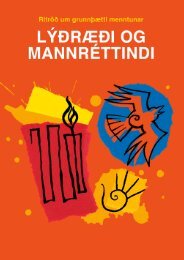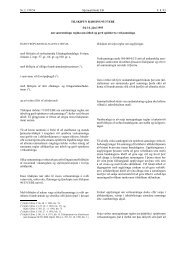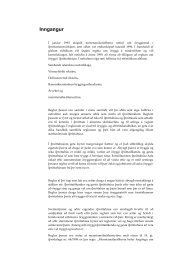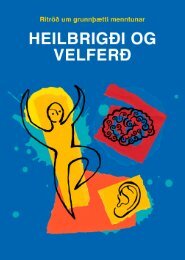Arts and Cultural Education in Iceland : Professor Anne Bamford
Arts and Cultural Education in Iceland : Professor Anne Bamford
Arts and Cultural Education in Iceland : Professor Anne Bamford
You also want an ePaper? Increase the reach of your titles
YUMPU automatically turns print PDFs into web optimized ePapers that Google loves.
Chapter 3: Responses to quality<br />
3.1 Introduction – Overall statements about quality<br />
‣ <strong>Arts</strong> education <strong>in</strong> Icel<strong>and</strong> is of high <strong>in</strong>ternational st<strong>and</strong>ard<br />
‣ More consideration needs to be given for out-of-school (especially music) provisions<br />
for children with special needs<br />
‣ <strong>Arts</strong> education <strong>in</strong> Icel<strong>and</strong> receives widespread support from pupils, parents <strong>and</strong> the<br />
community<br />
‣ There are generally adequate resources for effective, high quality arts education<br />
Us<strong>in</strong>g the approach developed <strong>in</strong> the previous chapter, the list of quality <strong>in</strong>dicators could be<br />
used as an alpha for arts education to determ<strong>in</strong>e ‘a wellness <strong>in</strong>dicator’ that can be used for arts<br />
education prior to impact measurement. It also acts as a diagnostic tool for improv<strong>in</strong>g arts<br />
education programmes.<br />
Generally, arts <strong>and</strong> craft education <strong>in</strong> Icel<strong>and</strong> is of a high <strong>in</strong>ternational st<strong>and</strong>ard. All children<br />
receive some arts education <strong>and</strong> most children receive <strong>in</strong> excess of two hours per week of arts<br />
education. Additional music education is enshr<strong>in</strong>ed <strong>in</strong> law <strong>and</strong> readily available across the<br />
country. There appears to be generally equitable provisions <strong>in</strong> all locations <strong>and</strong> for all children,<br />
though cont<strong>in</strong>u<strong>in</strong>g issues rema<strong>in</strong> for children with special needs.<br />
The arts are generally taught by well-tra<strong>in</strong>ed specialists <strong>in</strong> well-equipped <strong>and</strong> effectively<br />
resourced specialised arts studios (rooms). School pr<strong>in</strong>cipals, parents <strong>and</strong> the community<br />
support the value of the arts <strong>and</strong> they are considered as be<strong>in</strong>g a core part of education. The arts<br />
are a significant element of Icel<strong>and</strong>ic society <strong>and</strong> are valued for their <strong>in</strong>herent, personal <strong>and</strong><br />
social worth.<br />
Despite feel<strong>in</strong>gs that the st<strong>and</strong>ard of arts education <strong>in</strong> Icel<strong>and</strong> may be fall<strong>in</strong>g, this is not<br />
evidenced <strong>in</strong> the f<strong>in</strong>d<strong>in</strong>gs <strong>and</strong> the research shows ongo<strong>in</strong>g improvements <strong>in</strong> the place of arts<br />
education <strong>in</strong> schools <strong>and</strong> more generally with<strong>in</strong> Icel<strong>and</strong>ic communities.<br />
While there are areas that could be improved <strong>and</strong> recommendations that would <strong>in</strong>crease<br />
quality, these need to be read <strong>in</strong> terms of an overall very positive picture.<br />
3.2. Active partnership<br />
‣ Partnerships between the schools <strong>and</strong> outside agencies (artists, <strong>in</strong>dustry, cultural<br />
organisations) are not common <strong>in</strong> Icel<strong>and</strong> with the exception of some music schools<br />
which are embedded <strong>in</strong> close partnership with some schools<br />
‣ Partnerships should be extended, <strong>in</strong> terms of the number of schools <strong>in</strong>volved, the<br />
diversity of partner<strong>in</strong>g organisations <strong>and</strong> the length of time of the partnerships<br />
‣ Ongo<strong>in</strong>g partnerships between the education, culture <strong>and</strong> creative <strong>in</strong>dustry sectors<br />
needs to be embedded with<strong>in</strong> policy <strong>and</strong> practice<br />
‣ “Ground up” <strong>and</strong> community partnerships appear to be very strong <strong>and</strong> effective <strong>and</strong><br />
these could be more acknowledged <strong>in</strong> the curriculum<br />
‣ National cultural organisations based <strong>in</strong> Reykjavik need to be supported to develop<br />
<strong>in</strong>novative models for work<strong>in</strong>g more closely with schools <strong>in</strong> isolated locations<br />
‣ Schools should be encouraged to collaborate across various levels such as between<br />
preschool <strong>and</strong> the compulsory school; between the compulsory school <strong>and</strong> the senior<br />
53



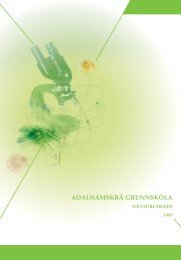
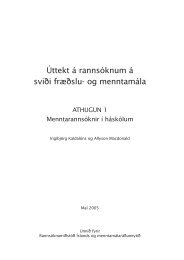

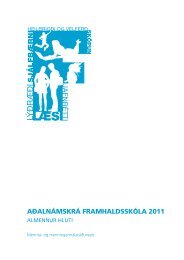
![Aðalnámskrá tónlistarskóla : rytmÃsk tónlist [Eingöngu á rafrænu formi]](https://img.yumpu.com/50843672/1/184x260/aaalnamskra-tanlistarskala-rytma-sk-tanlist-eingangu-a-rafranu-formi.jpg?quality=85)
